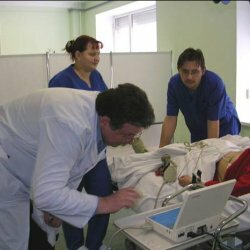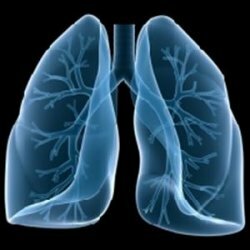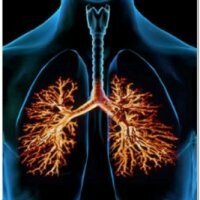Pulmonary haemorrhage: causes, symptoms, diagnosis, treatment
 Pulmonary bleeding is a very dangerous disease characterized by bloody discharge through the respiratory tract from the vessels of the bronchus or lungs and accompanied by a violation of the integrity of the blood vessels and the disintegration of lung tissue.
Pulmonary bleeding is a very dangerous disease characterized by bloody discharge through the respiratory tract from the vessels of the bronchus or lungs and accompanied by a violation of the integrity of the blood vessels and the disintegration of lung tissue.
The magnitude of pulmonary hemorrhage is determined by the intensity of blood loss.
In very severe conditions, the disease produces complications in the cardiovascular, respiratory and circulatory systems. The disease is typical for elderly people, smokers, patients with tuberculosis and other lung diseases.
First symptoms of
The first symptoms of the disease are:
- weakness;
- chest pain;
- hypotension;
- is an unconscious condition;
- dizziness;
- wheezing;
- lowering blood pressure;
- loss of consciousness;
- cough with brackish sputum with scarlet bloody clots.
In most cases, pulmonary hemorrhage begins with infrequent coughs, which eventually become permanent and intensify. There is an increased amount of sputum with blood impurities during expectoration.
A sharp increase in the amount of coughing blood indicates pulmonary hemorrhage.
Types of pulmonary hemorrhage
Given the volume of sputum produced by cough, pulmonary hemorrhages are classified into:
- small( daily release up to 100 ml);
- averages( the number of discharges from 100 to 500 ml);
- profuse( more than 500 ml of bloody discharge a day).
The most dangerous are sudden heavy bleeding that occurs spontaneously in a short time. In most cases, they lead to suffocation and death.
Diagnosis of the disease
At the first signs of pulmonary hemorrhage, a comprehensive examination is prescribed for diagnostic purposes, which includes:
- bronchoscopy;
- X-ray or ultrasound of the lungs;
- homography.
Sometimes, taking into account the progression of the disease progression, bronchography, algography and algopulmonography of bronchial arteries can additionally be prescribed.
Hemostatic therapy is often used to stop bleeding of the lungs.
Causes of the disease
Among the causes that most often lead to the emergence and development of pulmonary hemorrhage, allocate:
- cardiovascular diseases;
- all forms of pulmonary tuberculosis;
- bronchitis;
- repeated pneumonia;
- pneumosclerosis;
- lung abscess;
- influenza;
- hypertension;
- heart disease;
- inflammatory lung disease;
- ingress of foreign bodies into the respiratory tract;Injuries of the ribs and thorax;
- infectious and fungal lung lesions;
- pneumoconiosis of respiratory organs;
- is a malignant tumor of the respiratory tract.
Pulmonary bleeding can also occur as a consequence of lung surgeries.
An advanced form of the disease, not timely access to a doctor for help, leads to a fatal outcome.
Given the general condition of patients and the frequency of blood loss, the lethal outcome occurs in 15-80% of cases.
Diagnosis of the disease
To establish the correct diagnosis, a preliminary consultation of the following specialists is necessary: phthisiatrician, oncologist, cardiologist, rheumatologist, pulmonologist.
Comprehensive examination allows you to identify in the early stages of shortness of breath and wheezing in the sternum and lungs.
Also in time to identify the source of the disease can be by the color of blood. Pulmonary scarlet bleeding is usually indicated for pulmonary hemorrhage. Confirms pulmonary hemorrhage usually the procedure of MRI, X-ray or ultrasound of the lungs.
One of the best methods of instrumental diagnosis of pulmonary hemorrhage is considered bronchoscopy. It allows you to carefully investigate the source of bleeding, perform a biopsy of the pathology zone.
The results of blood tests for bleeding are characterized by a decrease in the hematocrit number, indicating anemia, anisocytosis, poikilocytosis.
To assess changes in the dynamics of treatment, a blood coagulogram study and an analysis of PCR of expectorant sputum for the presence of atypical cells, tuberculosis bacillus and other pathogens are assigned.
Treatment of pulmonary hemorrhage
Pulmonary bleeding requires in-patient treatment. When treating the disease, the following methods are used:
- local hemostasis;
- is conservative;
- surgical.
Medical treatment is effective for small and medium forms of pulmonary hemorrhage.
In this case, the patient is provided with peace and impose venous strands on the limbs. The blood is removed from the trachea by aspiration. At the first signs of asphyxia, frequent blood suction and emergency intubation are performed.
It is also planned to take antihypertensive and hemostatic drugs. Effective use of anticoagulants, glucose injections, blood transfusions. To stop blood with a bleeding vessel helps to clamp a tampon with adrenaline.
When conservative treatment methods fail to produce positive results, pulmonary hemorrhage is stopped by endoscopic hemostasis. Sometimes resort to bronchoscopy. In many cases, embolization of bronchial arteries will be effective, but it must be strictly controlled.
The above methods allow only for a while to stop bleeding. Completely stop it is possible only surgically, eliminating the source of bleeding.
Very rarely, in severe cases or contraindications to radical surgery, it is recommended to perform palliative intervention, which includes collapse and pneumotomy.
During a radical surgery, partially removed to healthy tissues or completely all pathologically altered areas of the lungs.
Prevention of the disease
Prevention of the treatment of the disease provides for timely examination and comprehensive treatment of the cardiovascular, respiratory and circulatory systems. Who is at risk of
? The most common risk group for pulmonary hemorrhage is:
- patients with acute pneumonia and tuberculosis;
- diabetics;
- pregnant women;
- migrants;
- convicts;
- persons taking glucocorticoid agents;
- children, often ill with pneumonia;
- the elderly;
- people of low socio-economic status.
It is important to remember that the main thing is not to stop bleeding, but to eliminate the cause of its occurrence. If the cause is an infection, anthelmintic and antibacterial drugs should be taken. In cases of tumors, it is advisable to remove them to prolong human life.



